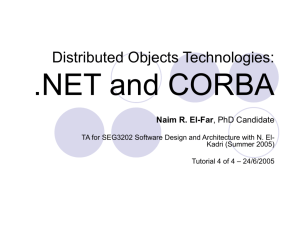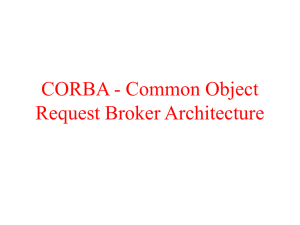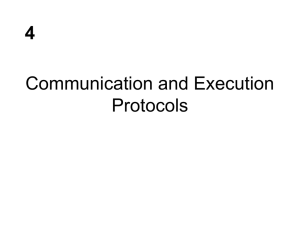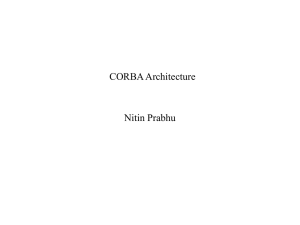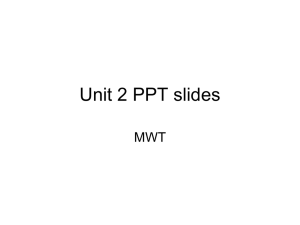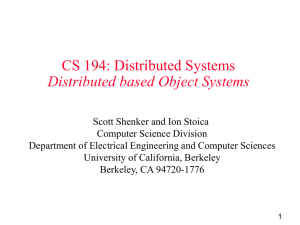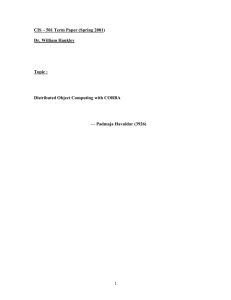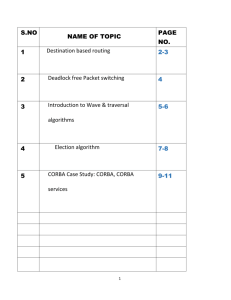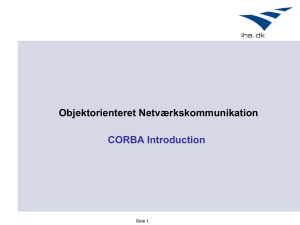The CORBA Architecture
advertisement
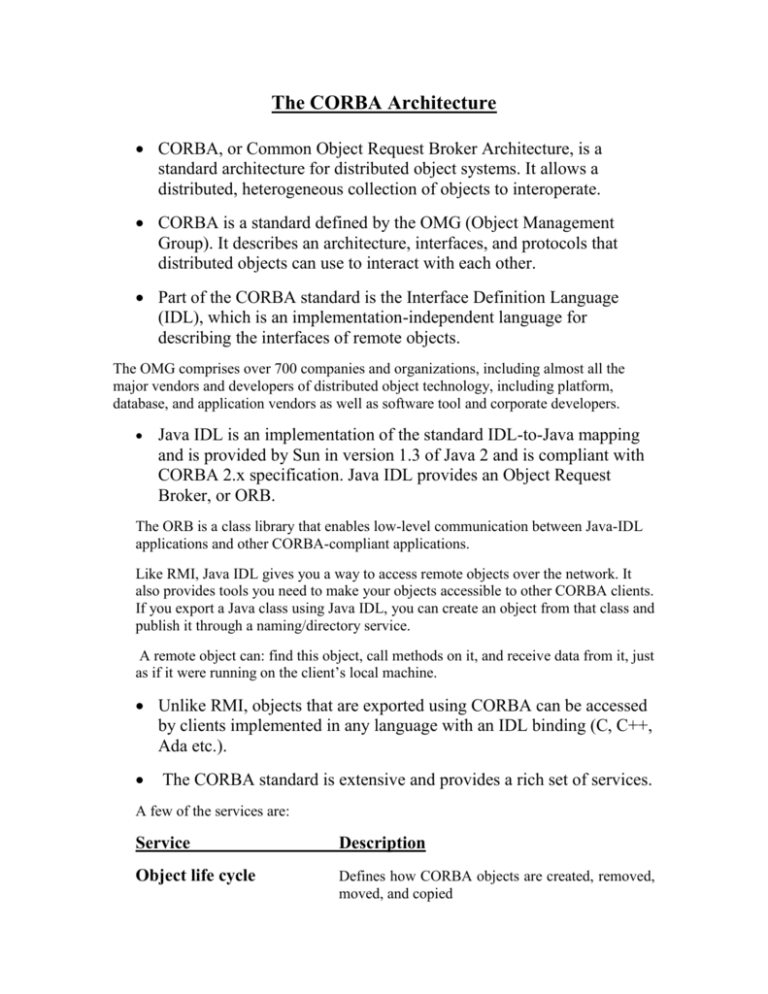
The CORBA Architecture CORBA, or Common Object Request Broker Architecture, is a standard architecture for distributed object systems. It allows a distributed, heterogeneous collection of objects to interoperate. CORBA is a standard defined by the OMG (Object Management Group). It describes an architecture, interfaces, and protocols that distributed objects can use to interact with each other. Part of the CORBA standard is the Interface Definition Language (IDL), which is an implementation-independent language for describing the interfaces of remote objects. The OMG comprises over 700 companies and organizations, including almost all the major vendors and developers of distributed object technology, including platform, database, and application vendors as well as software tool and corporate developers. Java IDL is an implementation of the standard IDL-to-Java mapping and is provided by Sun in version 1.3 of Java 2 and is compliant with CORBA 2.x specification. Java IDL provides an Object Request Broker, or ORB. The ORB is a class library that enables low-level communication between Java-IDL applications and other CORBA-compliant applications. Like RMI, Java IDL gives you a way to access remote objects over the network. It also provides tools you need to make your objects accessible to other CORBA clients. If you export a Java class using Java IDL, you can create an object from that class and publish it through a naming/directory service. A remote object can: find this object, call methods on it, and receive data from it, just as if it were running on the client’s local machine. Unlike RMI, objects that are exported using CORBA can be accessed by clients implemented in any language with an IDL binding (C, C++, Ada etc.). The CORBA standard is extensive and provides a rich set of services. A few of the services are: Service Description Object life cycle Defines how CORBA objects are created, removed, moved, and copied Naming Service The CORBA naming service provides a naming structure for remote objects. Event Service Another COS that provides a supplier-consumer communication model that creates asynchronous communication between the objects via an Event Channel. The flow of data into the Event Channel is handled by supplier objects, while the flow of data out of the event channel is handled by consumer objects. The Event Service supports both the push and pull model. In the push model, supplier objects control the flow of data by pushing it to consumers and in the pull model, consumer objects control the flow of data by pulling data from the supplier. Instead of directly communicating with each other, the supplier and consumer can each obtain a proxy object from the Event Channel and communicate with it. Supplier objects obtain a consumer proxy and the consumer objects acquire a supplier proxy. Persistent object service Transactions Coordinates atomic access to CORBA objects Concurrency Control Provides a locking service for CORBA objects in order to ensure concurrent access CORBA Products Several vendors provide CORBA products for various programming languages. The CORBA products that support the Java programming language include: ORB Description The Java 2 ORB The Java 2 ORB comes with Sun's Java 2. It is missing several features. The main feature it has is the ability to look up an object by name. VisiBroker for Java A popular Java ORB from Inprise Corporation. VisiBroker is also embedded in other products. For example, it is the ORB that embedded in the Netscape Communicator browser. Orbix A popular Java ORB from Iona Technologies. CORBA Architecture The major components that make up the CORBA architecture include the: Interface Definition Language (IDL), which is how CORBA interfaces are defined, Object Request Broker (ORB), which is responsible for all interactions between remote objects and the applications that use them, The Portable Object Adaptor (POA), which is responsible for object activation/deactivation, mapping object ids to actual object implementations. Naming Service, a standard service in CORBA that lets remote clients find remote objects on the networks, and Inter-ORB Protocol (IIOP). This figure shows how a one-method distributed object is shared between a CORBA client and server to implement the classic "Hello World" application. A one-method distributed object shared between a CORBA client and server. Architectural description: Any relationship between distributed objects has two sides: the client and the server. The server provides a remote interface, and the client calls a remote interface. These relationships are common to most distributed object standards, including RMI and CORBA. Note that in this context, the terms client and server define object-level rather than application-level interaction--any application could be a server for some objects and a client of others. In fact, a single object could be the client of an interface provided by a remote object and at the same time implement an interface to be called remotely by other objects. On the client side, the application includes a reference for the remote object. The object reference has a stub method, which is a stand-in for the method being called remotely. The stub is actually wired into the ORB, so that calling it invokes the ORB's connection capabilities, which forwards the invocation to the server. On the server side, the ORB uses skeleton code to translate the remote invocation into a method call on the local object. The skeleton translates the call and any parameters to their implementation-specific format and calls the method being invoked. When the method returns, the skeleton code transforms results or errors, and sends them back to the client via the ORBs. Between the ORBs, communication proceeds by means of a shared protocol, IIOP--the Internet Inter-ORB Protocol. IIOP, which is based on the standard TCP/IP internet protocol and works across the Internet, defines how CORBA-compliant ORBs pass information back and forth. Like CORBA and IDL, the IIOP standard is defined by OMG, the Object Management Group. IIOP allows clients using a CORBA product from one vendor to communicate with objects using a CORBA product from another vendor thus permitting interoperability, which is one of the goals of the CORBA standard. In addition to these simple distributed object capabilities, CORBA-compliant ORBs can provide a number of optional services defined by the OMG. These include services for looking up objects by name, maintaining persistent objects, supporting transaction processing, enabling messaging, and many other abilities useful in today's distributed, multi-tiered computing environments. Several ORBs from third-party vendors support some or all of these additional capabilities. The ORB provided with Java IDL supports one optional service, the ability to locate objects by name. Interface Definition Language (IDL) The services that an object provides are given by its interface. Interfaces are defined in OMG's Interface Definition Language (IDL). IDL is independent of any programming language. Mappings from IDL to specific programming languages are defined as part of the CORBA specification. Mappings for C, C++, Smalltalk, Ada, COBOL, and Java have been approved by OMG. The syntax of both Java and IDL were modeled to some extent on C++, so there are a lot of similarities between the two in terms of syntax. However, there are differences between IDL and Java. In IDL, you declare only the names and types for interfaces, data members, methods, method arguments etc. You do not include the method implementations. The method implementations are created in implementation language you choose after you’ve used an IDL compiler (idlj is the IDL compiler for Java) to convert your IDL interface to your target language. When you run the idlj compiler over your interface definition file, it generates the Java version of the interface, as well as the class code files for the stubs and skeletons that enable your applications to hook into the ORB. IDL includes, like C++, non-class data structure definitions like structs, unions etc. (these are not part of Java). Method parameters in IDL include modifiers that specify whether they are input, output, or input/output variables. In Java, all primitive data types are passed by value, and all objects are passed by reference. An IDL file can include multiple public interfaces. Java allows multiple inner classes within a single public class definition and multiple nonpublic classes per file, but only a single public class can be defined in a given Java file. Modules, which are similar to Java packages, can be nested within other modules in the same IDL file. In Java, you can define a class only within a single package in a single Java file. Object Request Broker (ORB) The core of the CORBA architecture is the ORB. Each machine involved in a CORBA application must have an ORB running in order for processes on that machine to interact with CORBA objects running in remote processes. Object clients and servers make requests through their ORBs and the remote ORB locates the appropriate object and passes back the object reference to the requestor. The ORB provides the communication infrastructure needed to identify and locate objects, handles connection management, etc. The ORBs communicate with each other via the IIOP. Requests made on the client stub are transferred from the client’s ORB to the ORB servicing the implementation of the target object. The request is passed onto the implementation through its skeleton interface. Once you run the idlj compiler, you can use the skeletons it generates to put together your server application. In addition to implementing the methods of the remote interface, your server code includes a mechanism to start the ORB and wait for invocation from a remote client. Similarly, you use the stubs generated by the idlj compiler as the basis of your client application. The client code builds on the stubs to start its ORB, look up the server using the name service provided with Java IDL, obtain a reference for the remote object, and call its method. Naming Service Defines how CORBA objects can be looked up by a name. It is a Common Object Service (COS) and allows an object to be published using a symbolic name and allows clients to obtain references to the object using a standard API. The CORBA naming service provides a naming structure for remote objects. IIOP The CORBA standard includes specifications for inter-ORB communication protocols that transmit object requests between various ORBs running on the network. The protocols are independent of the particular ORB implementations running at either end. An ORB implemented in Java can talk to an ORB implemented in C, as long as they are both compliant with the CORBA standard. The inter-ORB protocol delivers messages between two ORBs. These messages might be method requests, return values, error messages etc. The inter-ORB protocol (IIOP) also deals with differences between two ORB implementations, like machine-level byte ordering etc. As a CORBA developer, you don’t have to be concerned with the low-level communication protocol between ORBs. If you want two ORBs to talk, just make sure they both speak the same inter-ORB protocol (IIOP). The Inter-ORB Protocol (IIOP) is an inter-ORB protocol based on TCP/IP and so is extensively used on the Internet. POA CORBA Server Object POA ORB The POA connects the server object implementation to the ORB. It extends the functionality of the ORB and some its services include: activation and deactivation of the object implementations, generation and management of object references, mapping of object references to their implementations, and dispatching of client requests to server objects through a skeleton. Note: Follow the link: CORBA – An Example (Latest Version) within the course URL: http://www.unf.edu/~sahuja/cis6302/cis6302.html for an example on creating a complete CORBA application.
